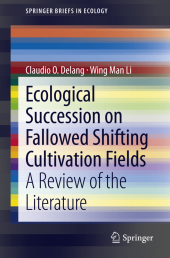 Neuerscheinungen 2012Stand: 2020-01-07 |
Schnellsuche
ISBN/Stichwort/Autor
|
Herderstraße 10
10625 Berlin
Tel.: 030 315 714 16
Fax 030 315 714 14
info@buchspektrum.de |

Claudio O. Delang, Wing Man Li
(Beteiligte)
Ecological Succession on Fallowed Shifting Cultivation Fields
A Review of the Literature
2012. viii, 127 S. 41 SW-Abb., 15 Tabellen. 235 mm
Verlag/Jahr: SPRINGER NETHERLANDS; SPRINGER, BERLIN 2012
ISBN: 9400758200 (9400758200)
Neue ISBN: 978-9400758209 (9789400758209)
Preis und Lieferzeit: Bitte klicken
The book reviews the literature on the ecological succession of plants on fallowed swiddens in tropical forests. Patterns of ecological succession in tropical forests are insufficiently understood, partly because results are scattered through a large number of case studies reported in academic articles. So far, no publication has attempted to bring these different case studies together to identify common patters and trends. The goal of the book is to review the different case studies, and identify common patterns of ecological succession in fallowed swiddens, as well as to pinpoint the factors that cause ecological succession in some areas to differ from those in other areas. The book is organised in four different sections: forest structure, forest diversity, species composition, and the factors that contribute to differences in forest recovery rates (the number of times the field was burned, the length of fallow period, the type of soil, and the type of forest). This book is an important contribution to tropical forestry and shifting cultivation. Deforestation and forest degradation are the largest sources of CO2, and shifting cultivation is one of the main culprits. For this (and other economic and political) reason governments attempt to curtail shifting cultivation by shortening the years the fields can be left fallow, or outright outlawing the farming practice. Yet, there is insufficient understanding of the processes of ecological succession in fallows, which raises the questions as to whether the policy fulfils its objectives.
1. Introduction
2. Forest structure
2.1. Introduction
2.2. Total aboveground biomass
2.3. Trees and herbs abundance
2.4. Total basal area
2.5. Canopy height
2.6. Plant density
2.7. Discussion and conclusions
3. Species richness and diversity
3.1. Introduction
3.2. Total species richness
3.3. Tree and herb species richness
3.4. Total species diversity
3.5. Discussion and conclusions
4. Species composition
4.1. Introduction
4.2. Succession from grasses to trees
4.3. Fallow length and species composition
4.4. Discussion and conclusions
5. Factors contributing to differences in forest recovery rates
5.1. Introduction
5.2. Number of times the field was burned
5.3. Length of fallow period
5.4. Type of soil
5.5. Type of forest
5.6. Discussion and conclusions
6. Conclusions


